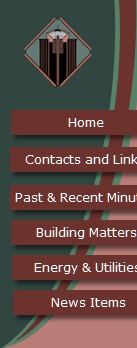
|
|






Fire-Safety, Energy Management, & Recyling Updated on 10 May 2007. Considerable new information, with emphasis on electricity-conservation, appears below the disclaimer. All information provided below and/or herein is subject to the Conditions of Use disclaimer. |
Conditions of Use: Before using the links below, viewers shall accept and agree that MTCC 1170 makes no representations or warranties with respect to any information provided on and/or in this web document relating to the links provided below, and expressly disclaims any implied warranties of merchantability, fitness for a particular purpose, or non-infringement with respect to such links. Furthermore, the inclusion of such links, and/or their information, does not constitute an endorsement by MTCC 1170 of the links and/or their information. The above-noted conditions also apply to MTCC 1170's Energy Management Committee Report (EMC Report). Until further notice, the EMC Report is simply a discussion document that the Board will carefully consider while the Ontario Government's conservation-policies evolve. Additionally, the Board will appreciate receiving owners' reactions to the EMC Report's suggestions, and to subsequently-posted information. Updated on 10 May 2007: CCI Toronto's Submission on Bill 21 What impact will Bill 21 have on condominiums' use of electrical energy? CCI Toronto has provided its opinion to the Ministry. A paragraph from that opinion is in the President's Report to MTCC 1170's AGM 2007. The Report's addenda include MTCC 1170's statistics on electricity-use. A reasonable interpretation might be that those statistics support CCI Toronto's opinion. Updated on 30 April 2007: Bill 21 and Smart Metering Within a fortnight, MTCC 1170 will try to provide further, and more specific information about condominium-related advocacy groups' submissions on Bill 21. Where possible, MTCC 1170 will provide data that will assist owners in relating the above-noted submissions to Bill 21's impact on the Corporation. Bill 21 2006 is An Act to enact the Energy Conservation Leadership Act, 2006 and to amend the Electricity Act, 1998, the Ontario Energy Board Act, 1998 and the Conservation Authorities Act. The link to Bill 21 also provides information about the products covered by the Ontario Energy Efficiency Act. Bill 21 has considerable implications for condominiums. Pending among those implications is a requirement for smart sub-metering. The requirement for smart sub-metering is even applicable to condominiums like MTCC 1170 that currently use bulk metering. What if our Declaration (or any other condominium's) explicitly or implicitly treats provision of electricity as a common element? The Canadian Condominium Institute and the Power Marketing Association make the point that energy conservation takes precedence over declarations, and over the requirement for an 80% vote. Submetering for Condos offers additional information. Posted on 28 October 2006: Reducing Our Electricity Costs SmartLiving St Lawrence: With its involvement in the SLNA, MTCC 1170 decided to augment SmartLiving St Lawrence's conservation efforts. The result is a collection of in-house files, external files, and external links. These are freely available to MTCC 1170's residents, and to our neighbours. Realistic goals for condos: With the plethora of available conservation materials, condominium corporations must be selective. Also, they must be realistic when they attempt to implement conservation measures. For MTCC 1170, some possible opportunities and limitations appear in its Introduction to Electricity Conservation. High rise buildings and energy-conservation: Additional information, in easily readable format, is available in a Canada Mortgage and Housing document, Healthy High Rises. Even if you lack time for the entire document, the graph on page 4 will surely interest you. That graph shows high-rises' average energy consumption relative to other types of housing. The document also describes conservation measures that high-rise buildings can implement, especially when their existing equipment comes up for replacement. Your suite's wiring: As for small steps that residents can begin taking immediately, MTCC 1170 provides an initial set of in-house documents. As an introduction, you can learn about a typical suite's wiring system by reading Decoding Home Wiring. Next, you can learn to measure your individual appliances' electricity-usage by going to Measuring Appliance-Wattage. How you can begin practising conservation: In the next four documents, MTCC 1170 shows how to turn theory into practice. How much electricity does that pot of coffee require? Electrical Jolt in Coffee explains it all for you. What impact does your computer have on MTCC 1170's total electricity bill? Computers' Electrical Consumption provides some insight. Additional data, from the Canadian Association of Community Colleges, is consistent with MTCC 1170's research. Do you want to help your computer to use as little electricity as possible? If so, you can learn more by going to Economical Computer Operation. What you should know about adopting compact fluorescent lights (CFLs): In its Introduction to Electricity Conservation, MTCC 1170 uses compact fluorescent lights (CFLs) as an example of possible savings. Given their obvious ability to reduce electricity bills, why have CFLs failed to push incandescent bulbs from store-shelves? Initially, CFLs were fearfully expensive. Because of their high cost, payback-time was very long. (Payback-time is the time it takes for lower electricity bills to "pay for" the investment in new technology.) However, high costs are no longer an issue for CFLs. By October 2006, 13-Watt CFLs were often available for $2 to $3 each. A 13-Watt CFL provides 800 lumens of light. Coincidentally, this is the same amount of light that a 60-Watt incandescent bulb provides. However, the first motivator is that a 13-Watt CFL uses only 22% of the amount of electricity that a 60-Watt incandescent bulb does. The second motivator is that a 13-Watt CFL lasts six to 10 times as long as an equivalent CFL does. Despite CFLs' obvious benefits, some doubts and objections persisted. Some people pointed to the fact that CFLs contain tiny amounts of mercury. Others recalled early CFLs' "cold" quality of light and asked how they could identify CFLs with "warmer" light. In CFL Data for the St Lawrence Neighbourhood Association, MTCC 1170 answers the questions about mercury, and about identifying CFLs with a "warmer" quality of light. Even people who favoured CFLs had questions about CFLs and existing light-sockets. Would CFLs with high light output require more electricity than existing light-sockets could handle? MTCC 1170's CFL Socket Compatibility document should provide all of the necessary answers, as well as allaying unnecessary fears. As a final adaptation issue, many homes use tri-lights, especially in living rooms and bedrooms. CFL tri-lights are somewhat larger than equivalent incandescent tri-lights are. Sometimes, CFL tri-lights are too large for the harp-shaped bracket-wire that surrounds the bulb and holds the lampshade in place. MTCC 1170's CFL Tri-Light Adaptation shows a cheap, easy, aesthetically pleasing method for adapting existing table and floor lamps to CFL tri-lights. External agencies' and governments' roles: For learning more about energy-saving appliances and lighting, Canada's Energy Star site is a good starting-point. To learn about energy-saving tips and financial incentives, go to Ontario's Conservation Bureau site and to the Ontario Energy Board site. Additionally, Ontario's Ministry of Energy provides a brochure, Conserve Energy and Save Money. Differentiating among fads, junk-science, and durable solutions: Unsurprisingly, no, you should not. For example, the previous brochure suggests that you should "Allow hot foods to cool before putting them in the refrigerator." If applied improperly, that bit of advice could be an invitation to food-poisoning. Therefore, you should also read Canadian Partnership for Consumer Food Safety Education's brochure, Focus on Chill. Other potentially good ideas deserve equally careful scrutiny before implementation. Example #1: How effective is "free" distribution of resource-saving devices? Does conservation automatically occur? The Australian experience shows the necessity to pay greater attention to details. Example #2: Do programmable thermostats always result in lower energy usage? A research study suggests that users' motivation is at least as important as devices are. Indeed, the study goes a long way towards confirming the viewpoint in MTCC 1170's Introduction to Electricity Conservation. Posted on 20 October 2005: Dryer-Vent Cleaning at MTCC 1170 As the Minutes for Board Meeting 051019S indicate, biennial dryer-vent cleaning will occur during the 2005-2006 fiscal year. Residents unfamiliar with the necessity for dryer-vent cleaning might wish to review the Board's enabling motion, and the explanations available at the Ontario Fire Marshal site and the CMHC site. Posted on 19 August 2005: Toronto's Residential Washing Machine Cash Incentive Program Except for post-Declaration replacements, many suites' clothes washers are now eight years old. Before replacing clothes washers, owners should view the City of Toronto's Cash Incentive Programme. A $60 rebate is available, "...for the purchase of a City-selected, high-efficiency clothes washer." Some Metropole residents have already purchased qualifying clothes washers. They report having already received their rebates from the City. Many newer clothes washers have a more efficient spin-cycle. This decreases the time & electricity that clothes dryers formerly needed to complete the laundry-cycle. Posted on 13 June 2005: Recycling In May 2005, MTCC 1170's Management Office and Board of Directors received information about possible levies on multi-residential buildings. These levies could reflect the extent to which multi-residential buildings fail to meet their recycling targets. Much confusion abounds about the City's plans. Also, many residents are unaware of items that are recyclable. The following link should help to resolve that point: Recycling Materials in Toronto. More comprehensive information about the City's recycling criteria and/or planning is available at the following sites: http://www.city.toronto.on.ca/garbage http://www.city.toronto.on.ca/garbage/multi/index.htm The first site provides general information, applicable to all residents. The second site is specific regarding multi-residential buildings. Additional information is available at the Recycling Council of Ontario site: http://www.rco.on.ca Posted on 15 April 2005: Energy-Saving Tips Recently, Toronto's print media have reported extensively on Ontario's existing electricity sources, current needs, and possible strategies -- all of which appear to require conservation. As a research-service to owners and residents, MTCC 1170 encloses the links that appear below -- subject to conditions stated herein. New Information on Compact Fluorescent Lighting -- 15 April 2005 By now, everyone should be aware that compact fluorescent lights or "bulbs" are (a) significantly more efficient than incandescent bulbs, and (b) much cheaper than they were a few months ago. Thus, energy-conscious owners and/or residents will already have begun replacing incandescent bulbs with compact fluorescent lights (CFLs). However, prospective purchasers of CFLs can also attain another advantage; namely, full-spectrum lighting. The latter refers to lighting that purports to provide at least some of the advantages of sunlight. As time permits, this site might be able to provide additional sources of information. For now, the following link will take readers to some of the information available at Canada's Institute for Research in Construction site (a branch of Canada's National Research Council). Is Full-Spectrum Lighting Special? Aside from offering research on full-spectrum lighting, the above-noted link names products that comply with the author's criteria for that type of lighting. As users see fit, they can use the information as and when they choose to convert from incandescent bulbs to CFLs Regardless of their choice of type or brand of CFL, users should bear in mind that the average 13 Watt CFL uses about 22% of the electricity that a 60 Watt incandescent bulb does. As for illumination, a 13 Watt CFL produces 825 lumens -- about the same as for a 60 Watt incandescent bulb. Finally, as for lifespan, the advertised life of a CFL is usually at least 400% of the advertised life of an equivalent incandescent bulb. The bottom line is that we can all do our part for conservation (of money and of energy-sources) by switching to more efficient lighting. CFLs are one of the starting points for meeting Canada's "one-tonne challenge". MTCC 1170's EMC Report - Principal Recommendations How Stuff Works: A Great Starting Point for Understanding Appliances, Plumbing, etc Ontario Ministry of Energy: Energy-Saving Tips for Your Home Case Study: A GTA Hotel's Experience with Cost-Benefits of Energy-Management |